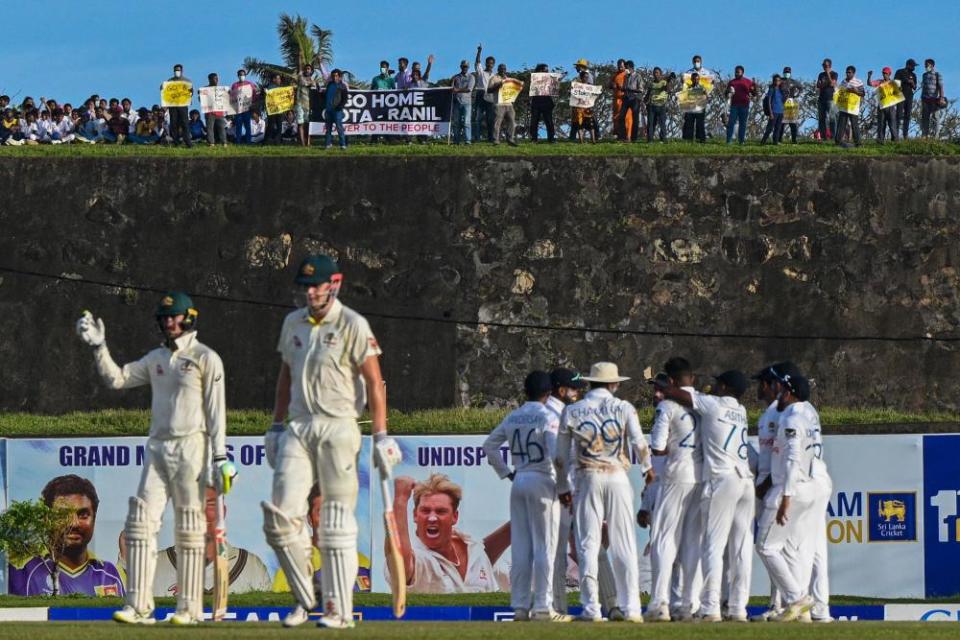Where bat meets Galle: why cricket is the least of Sri Lanka’s tests

Watching cricket at Galle, you are joined by the Indian Ocean on either side. Off the southern curve of the teardrop shape of Sri Lanka, a short promontory juts into the sea. Most of it is taken up by Galle Fort, vast in bulk and rising from level ground in an imposing apparition of stone. From Portuguese to Dutch to British to its modern Sri Lankan tourism incarnation, its eras reveal themselves in patches like different coats of varnish wearing through. People shelter from the rain under its central archway. A bird flies like an arrow into a tiny hole worn high in the rock. On a patch of grass below, lush with rainfall, 60 kids armed with cricket bats practice pull shots and drives in a soundless ballet.
Related: Australian spinners rip through Sri Lanka to wrap up first Test inside three days
At the neck of the promontory, where it narrows, the oval sits like a pendant at its throat. The playing area and the trees beyond glow emerald in the sun. From its seats, one view faces the fort wall. The opposite side faces the broadening city. Then on the flanks, that ocean. There are plenty of cricket grounds that show you water from a distance: some river or estuary, a blue background miles away, tiny boats for a zoom lens to tremble on. Here, it is close enough for detail. A heaving surface of green and grey. Waves thunder in, that white foaming herd of horses, snorting and jostling before crashing to shore. All day, in the stands, you hear that surge and swell, lulling you or lifting you on your own personal tide.
Galle does its own version of hot. The kind of tropical heat that wraps around you like wet cloth. You can carve out tiny sanctuaries of air-conditioning, but you are living in denial. Always, outside, it is waiting like the dark beyond the light switch. At times the sea breeze carves across the town, offering relief to those lucky enough to have found shade. The moment, though, that you find yourself in any airless space, you will sweat with a full-body totality, every surface of your skin covered. You are a tiny human flood.
On the second morning of the first Test between Sri Lanka and Australia, the sky turns wild. Clouds compete for space in the choking atmosphere. A deluge begins, not falling in drops but in great chunks of rain, water smacking the earth like an open palm. The wind picks up, then up further. It tears down the shade structure over a grandstand. It knocks over TV cameras on their gantry. It wrenches free a row of windows and smashes them. It threatens to carry the radio marquee off the roof, trailing some unfortunate commentator into the sky by a rope like an unhappy Mary Poppins.
Within a couple of hours, play has resumed. The sun has returned. The ground staff in their dozens shift tarpaulins that they had earlier spread over the entire field, shuffling water from one to the next so that the arena stays dry. The damage beyond the field is treated with equanimity, storm as a part of life.
It’s tempting to make make generalisations about resilience. In 2022, watching cricket at Galle is different. Ringing the ground along hundreds of metres of footpath is a line of blue propane bottles, padlocked together so they may not be easily hauled away, brought here from home kitchens as a statement by residents of a country that has no supplies to refill them. Sri Lanka’s economic crisis has sent up the price of essentials while creating a shortage of medicines and other imports. With petrol among them, the lack of transport has closed schools and sunk businesses.
Galle cricket ground is a natural focus for protest, placed as it is next to the main train station, bus depot, post office and town hall. Against the walls of the stadium is a small encampment from Gota Go Gama, the recent nationwide campaign against the nepotistic Rajapaksa family that dominates Sri Lankan politics. At stumps on the first day a loud march takes place outside the gates. On the walls of the fort overlooking the ground, where people sit for a free view of matches, protesters are chased away by soldiers. According to the army, beyond a sight screen sized like the sails of a three-mast schooner, tiny protest banners would distract the cricketers. TV cameras are ordered not to point in that direction, presumably because it would distract the viewers.
As for the Sri Lankan cricket team, Galle might be home ground but it hasn’t been one for happy hunting. In five Tests against Australia here over 23 years, the two-day thrashing Sri Lanka dished out in 2016 is their only win. Last week, Australia returned the favour even more quickly to notch their third. The next match of this series, starting on Friday, will be played in the same place to economise on travel. The pitch will again be dry, shorn of grass, not just baked by the sun but scoured by salt winds. It is not a place for unsure batting lineups to prosper. Yet a few days from now, Sri Lanka will have to dust off and go again. And again, you could draw the obvious parallels. But painting virtue in suffering is a way of diminishing it. There are times when nothing is so cheap as metaphor.

 Yahoo Sport
Yahoo Sport 





































